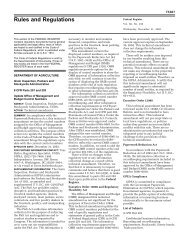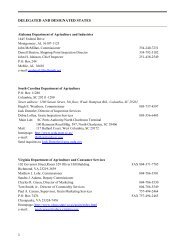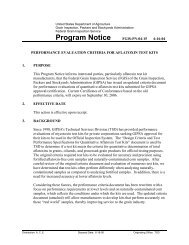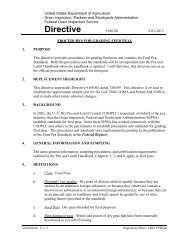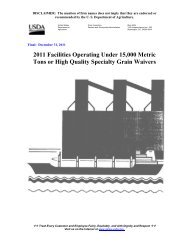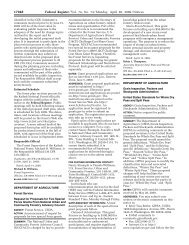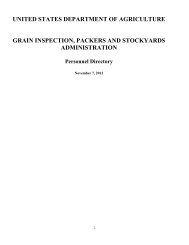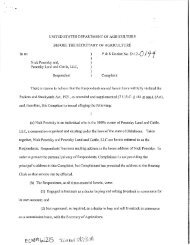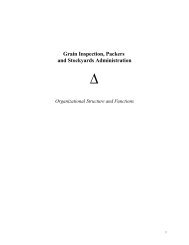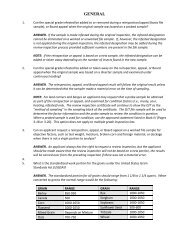Assessment of the Cattle and Hog Industries Calendar Year 2000
Assessment of the Cattle and Hog Industries Calendar Year 2000
Assessment of the Cattle and Hog Industries Calendar Year 2000
Create successful ePaper yourself
Turn your PDF publications into a flip-book with our unique Google optimized e-Paper software.
shifted to feedlots, where packers purchase fed cattle directly from cattle owners, or from<br />
feedlot managers who represent <strong>the</strong> owners.<br />
Spot market procurement <strong>of</strong> fed cattle generally occurs over a week-long period. At <strong>the</strong><br />
beginning <strong>of</strong> <strong>the</strong> week, packer buyers visit feedlots where <strong>the</strong>y receive a list <strong>of</strong> cattle<br />
(show list), which indicates <strong>the</strong> cattle available by pen. The buyers view <strong>the</strong> cattle on <strong>the</strong><br />
show list to estimate <strong>the</strong>ir value. The feedlot manager informs each buyer <strong>of</strong> <strong>the</strong> asking<br />
prices for <strong>the</strong> cattle. The buyer may or may not make bids. The packer’s head buyer,<br />
who is usually at <strong>the</strong> corporate headquarters, generally sets <strong>the</strong> maximum price a buyer<br />
can bid.<br />
The process by which buyers <strong>and</strong> sellers arrive at bid <strong>and</strong> ask prices is part <strong>of</strong> <strong>the</strong> process<br />
referred to as price discovery. Among o<strong>the</strong>r things, <strong>the</strong> buyers <strong>and</strong> sellers monitor<br />
reported spot market sales, <strong>the</strong> Chicago Mercantile Exchange (CME) Live <strong>Cattle</strong> Futures<br />
quotes, <strong>and</strong> wholesale meat prices to help <strong>the</strong>m determine how much <strong>the</strong>y will bid or<br />
accept. In recent times, buyers generally increase bids in $0.50 or $1.00 per cwt<br />
increments in <strong>the</strong> bidding process.<br />
The date <strong>and</strong> time <strong>of</strong> delivery <strong>and</strong> who pays for delivery also are important elements <strong>of</strong> a<br />
transaction. A packer may be willing to <strong>of</strong>fer a price premium if, for example, a feedlot<br />
is willing to deliver <strong>the</strong> cattle in <strong>the</strong> early morning so <strong>the</strong> packer has an inventory <strong>of</strong> cattle<br />
to start its first slaughter shift <strong>of</strong> <strong>the</strong> day.<br />
Managers <strong>of</strong> custom feedlots may contact <strong>the</strong> cattle owners (customers) before accepting<br />
a bid on behalf <strong>of</strong> <strong>the</strong> owners, to apprise <strong>the</strong>m <strong>of</strong> <strong>of</strong>fers or general market conditions, <strong>and</strong><br />
make recommendations about whe<strong>the</strong>r to accept a bid. When a deal is struck, <strong>the</strong> seller<br />
<strong>and</strong> buyer <strong>the</strong>n agree on a date <strong>and</strong> time when <strong>the</strong> cattle will be shipped.<br />
Recently, many producers have reported <strong>the</strong> perception that <strong>the</strong>re has been a reduction in<br />
<strong>the</strong> length <strong>of</strong> <strong>the</strong> “trading window.” The trading window refers to <strong>the</strong> time interval<br />
during which <strong>the</strong> bulk <strong>of</strong> cattle are sold each week. Buyers <strong>and</strong> sellers engage in price<br />
discovery through <strong>the</strong> week, monitoring several information sources before making<br />
trades. Eventually, <strong>the</strong> market price is established <strong>and</strong> trade occurs. The bulk <strong>of</strong> trading<br />
may occur during a relatively short period. Some feedlot managers report that <strong>the</strong>y <strong>of</strong>ten<br />
receive multiple bids in rapid succession, <strong>and</strong> must decide quickly whe<strong>the</strong>r to accept an<br />
<strong>of</strong>fer or wait for a better <strong>of</strong>fer. During its 1996 Texas Panh<strong>and</strong>le Fed <strong>Cattle</strong> investigation,<br />
P&SP did not observe <strong>the</strong> short trading window people claimed existed. The highest<br />
volumes <strong>of</strong> cattle were purchased on Wednesdays, but spot-market transactions occurred<br />
on every business day <strong>of</strong> <strong>the</strong> week. Never<strong>the</strong>less, <strong>the</strong> time within <strong>the</strong> week during which<br />
<strong>the</strong> bulk <strong>of</strong> spot market cattle are traded may be shortening over time.<br />
Non-Spot Market Procurement Methods<br />
The term “non-spot market procurement” refers to all transactions in which <strong>the</strong> cattle are<br />
committed to a packer before <strong>the</strong> cattle are ready for slaughter, <strong>and</strong> transactions in which<br />
<strong>the</strong> price is not established at <strong>the</strong> time <strong>the</strong> sales commitment is made. Three common<br />
12



